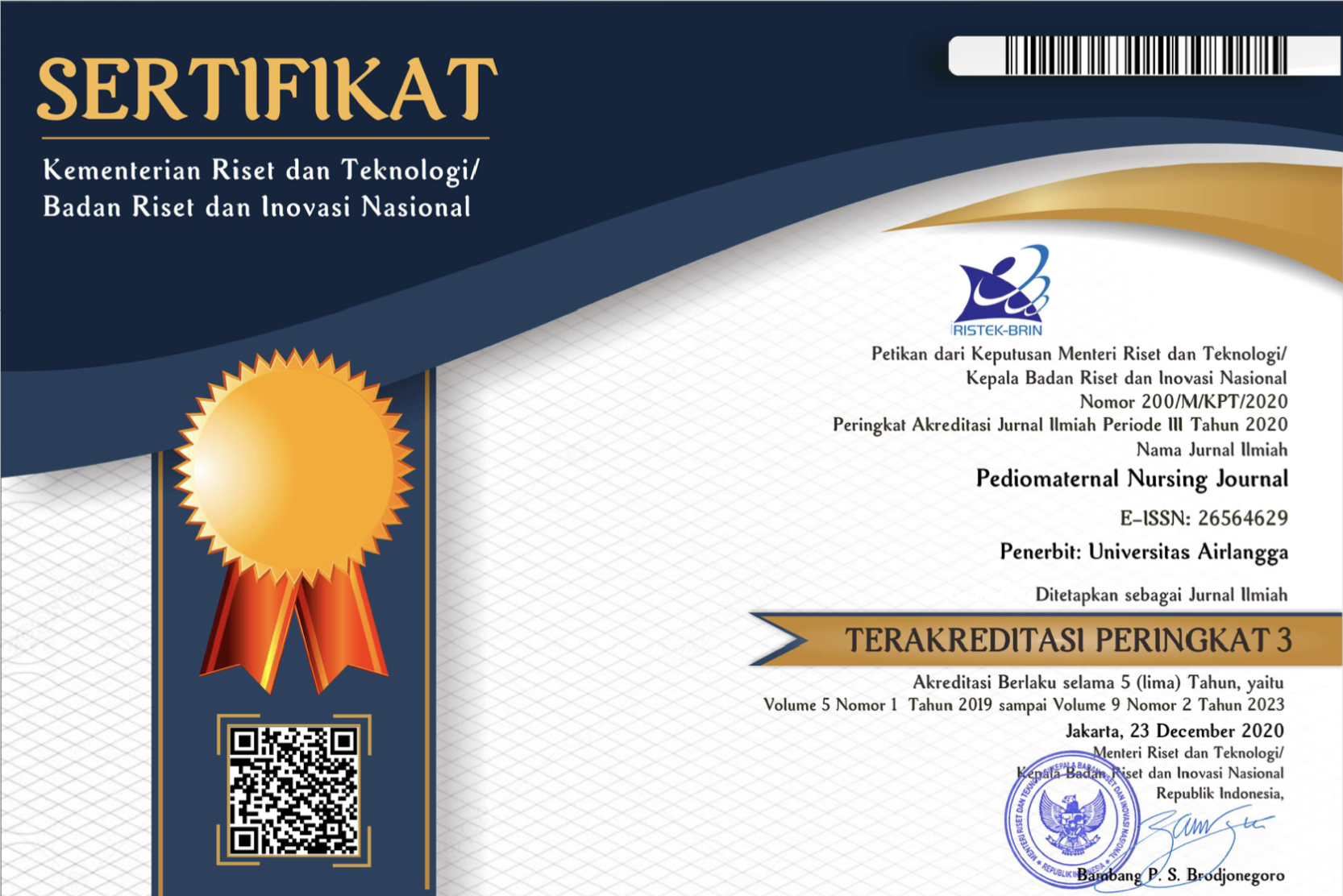Analisis Faktor yang berhubungan dengan Pencegahan Stunting pada Anak Usia 2-5 Tahun berdasarkan Teori Health Promotion Model (HPM)
Downloads
Introduction: Indonesia still faced nutritional problems in children is like stunting. Stunting is one of conditions of malnutrition in child that need to be solved in Indonesia because it can affect the quality of the next generation. This study aimed to analyze the factors related to prevention of stunting in children based on Theory of the Health Promotion Model (HPM).
Methods: This study used a cross-sectional design. The population was mothers who have children aged 2-5 years with number of samples are 141 people using purposive sampling technique. The independent variables were prior related behavior, education level, socio-economic status, perceived benefits to action and perceived barrier to action. Dependent variable was prevention of stunting. Data were collected using questionnaire and analyzed using logistic regression with a significance level α <0.05.
Results: A positive stunting prevention behavior were 66.7% (94 people). Factors related to stunting prevention behavior were prior related behavior (p=0.03). While for other independent factors are level of education (p=0.74), socioeconomic status (p=0.07), perceived benefits to action (p=0.35) and perceived barrier to action (p=0.31) have no relationship with stunting prevention. The result of analysis on the prior related behavior had 2.81 times better in stunting prevention with a significance level is 0.03.
Conclusion: The behavior of stunting prevention is influenced by prior related behavior that is supplementary feeding for pregnant women, overcoming iron and folic acid deficiency, providing worm medicine, providing complete immunization and preventing and treating diarrhea.
Child WHO, Standards G, W H O. Training Course on Child Growth Assessment. World Heal Organ Train Course Child Growth Assessment Geneva. 2008;WS 103:1–116.
MCA Indonesia. Stunting dan Masa Depan Indonesia. Millenn Chall Acc - Indones. 2013;2010:2–5.
WHO. What's At Stake. WhoInt. 2014;(9):1–10.
Kemenkes. Kementerian {Kesehatan} {Republik} {Indonesia}. In Kementeria Kesehatan Republik Indonesia; 2017.
Pender NJ. Health Promotion in Nursing Practice. 2015.
Trihono, Atmarita, Tjandrarini DH, Irawati A, Utami NH, Tejayanti T, et al. Pendek (Stunting) di Indonesia, Masalah dan Solusi. Lembaga Penerbit Balitbangkes. 2015. 218 p.
Kemenkes. Kementerian Kesehatan Republik Indonesia. August. 2013.
Illahi RK, Muniroh L. Gambaran Sosio Budaya Gizi Etnik Madura. Media Gizi Indones. 2016;11(2):135–43.
Nadhiroh KN dan SR. Faktor Yang Berhubungan Dengan Kejadian Stunting Pada Balita. J Media Gizi Indones. 2015;10(Faktor yang berhubungan dengan kejadian stunting):13–9.
Biro Humas Prov. Jatim. 2017.
Nasikhah R. Faktor Risiko Kejadian Stunting Pada Balita. Univ Diponegoro. 2014;1:1–27.
Kamal MS. Socio-economic determinants of severe and moderate stunting among under-five children of rural Bangladesh. Malays J Nutr. 2011;17(1):105–18.
Sereebutra P, Solomons N, Aliyu MH, Jolly PE. Sociodemographic and environmental predictors of childhood stunting in rural Guatemala. Nutr Res. 2006;26(2):65–70.
Wright KO, Shogbamimu Y, Akinbami A, Adebisi R, Senbanjo I, Iolade A. Nutritional status of children in a well-child clinic in Lagos, Nigeria. African J Food, Agric Nutr Dev. 2018;18(03):13602–16.
Bomela N. Child nutritional status and household patterns in South Africa. African J Food, Agric Nutr Dev. 2007;7(5):un-un.
Manurung JJ, Adler H. Manurung. Ekonomi Keuangan dan Kebijakan Moneter. Pertama. Jakarta: Salemba Empat; 2009.
Fikawati S dan AS. Kajian Implementasi dan Kebijakan Air Susu Ibu Eksklusif dan Inisiasi Menyusu Dini di Indonesia. Makara Kesehat. 2010;14(1):17–24.
Fikrina LT, Rokhanawati D. Hubungan tingkat sosial ekonomi dengan kejadian stunting pada balita usia 24-59 bulan di desa Karangrejek Wonosari Gunung Kidul. 2017;1–13.
Hapsari W. Hubungan Pendapatan Keluarga Pengetahuan Ibu Tentang Gizi Tinggi Orang Tua Dan Tingkat Pendidikan Ayah Dengan Kejadian Stunting Pada Anak Umur 12-59 Bulan. Skripsi. 2018;300.
Santrock J. Adolescence: Perkembangan Remaja. Jakarta: Erlangga; 2003.
Potter & Perry. Fundamental Keperawatan. 2nd ed. Jakarta: EGC; 2006.
Sukmawati, Hendrayati, Chaerunnimah, Nurhumaira. Status Gizi Ibu Saat Hamil, Berat Badan Lahir Bayi Dengan Stunting Pada Balita. Media Gizi Pangan. 2018;25(1):18–24.
Soetjiningsih. Buku Ajar II Perkembangan Anak dan Remaja. Jakarta: Buku Kedokteran EGC; 2012.
Swathma D, Lestari H, Teguh R. Riwayat Imunisasi Dasar Terhadap Kejadian Stunting Pada Balita Usia 12-36 Bulan Di Wilayah Kerja Puskesmas Kandai Kota Kendari Risk Factors Analysis of Low Birth Weight , Body Length At Birth and Basic Immunization History Toward Stunting of Children Aged. 2016;1–10.
Mj E, Cheah WL, Lee PY. Factors Influencing Malnutrition among Young Children in serawak. 2014;20(2).
Ningrum EW, Utami T. Hubungan Antara Status Gizi Stunting Dan Perkembangan Balita Usia 12-59 Bulan. J Bidan. 2017;70–9.
Hanum NL, Khomsan A. Pola Asuh Makan, Perkembangan Bahasa , dan Kognitif Anak Balita Stunting dan Normal di Kelurahan Sumur Batu, Bantar Gebang Bekasi. J Gizi dan Pangan. 2012;7(2):81–8.
Hassanpour S, Langlotz CP, States U. The effect of early childhood stunting on children's cognitive achievements: Evidence from young lives Ethiopia. Ethiop J Heal Dev. 2017;31(2):29–39.
Mayasari D, Indriyani R, Ikkom B, Kedokteran F, Lampung U, Tanjungkarang PK, et al. Stunting , Faktor Resiko dan Pencegahannya Stunting , Risk Factors and Prevention. 2018;5:540–5.
Hanifah L, Wulansari R, Meiandayati R, Laksminingsih E. Stunting trends and associated factors among Indonesian children aged 0-23 months : Evidence from Indonesian Family Life Surveys ( IFLS ) 2000 , 2007 and 2014. 2018;24(3):315–22.
Maywita E. Faktor Risiko Penyebab Terjadinya Stunting Pada Balita Umur 12-59 Bulan Di Kelurahan Kampung Baru Kec . Lubuk Begalung Tahun 2015 Risk Factors Cause the Stunting of Age 12-59 Months in Kampung Baru Kec . Lubuk Begalung in 2015 Erni Maywita Dosen Tetap Fak. J Ris Hesti Medan. 2018;3(1):56–65.
Has ES and A. Model pengembangan pemenuhan kebutuhan gizi anak prasekolah berbasis. J Ners. 2012;7(2):121–30.
Copyright (c) 2019 Ribka Putri Sholecha, Esti Yunitasari, Ni Ketut Alit Armini, Yuni Sufyanti Arief

This work is licensed under a Creative Commons Attribution 4.0 International License.
1. The journal allows the author to hold the copyright of the article without restrictions.
2. The journal allows the author(s) to retain publishing rights without restrictions.
3. The legal formal aspect of journal publication accessibility refers to Creative Commons Attribution (CC BY).





















